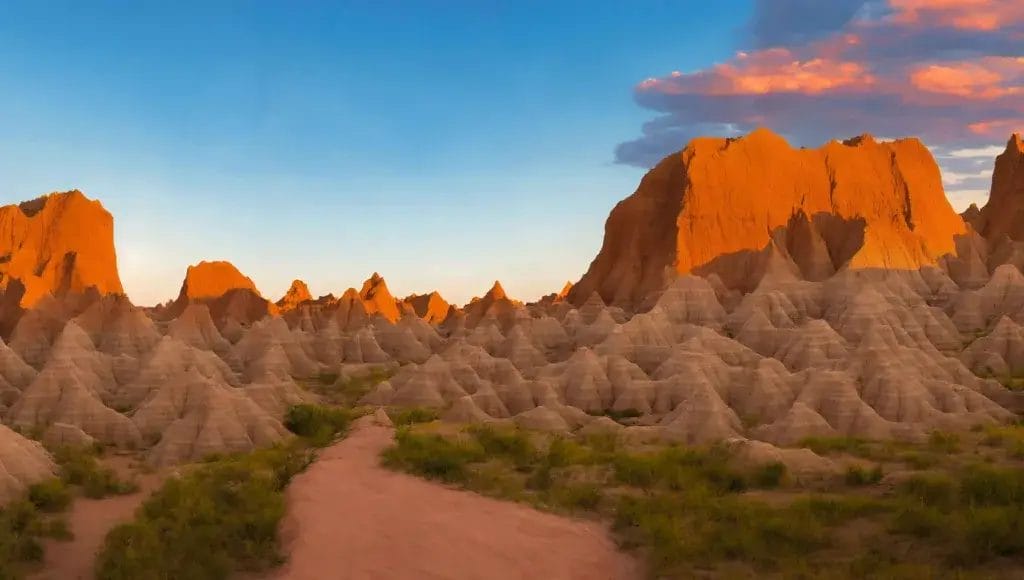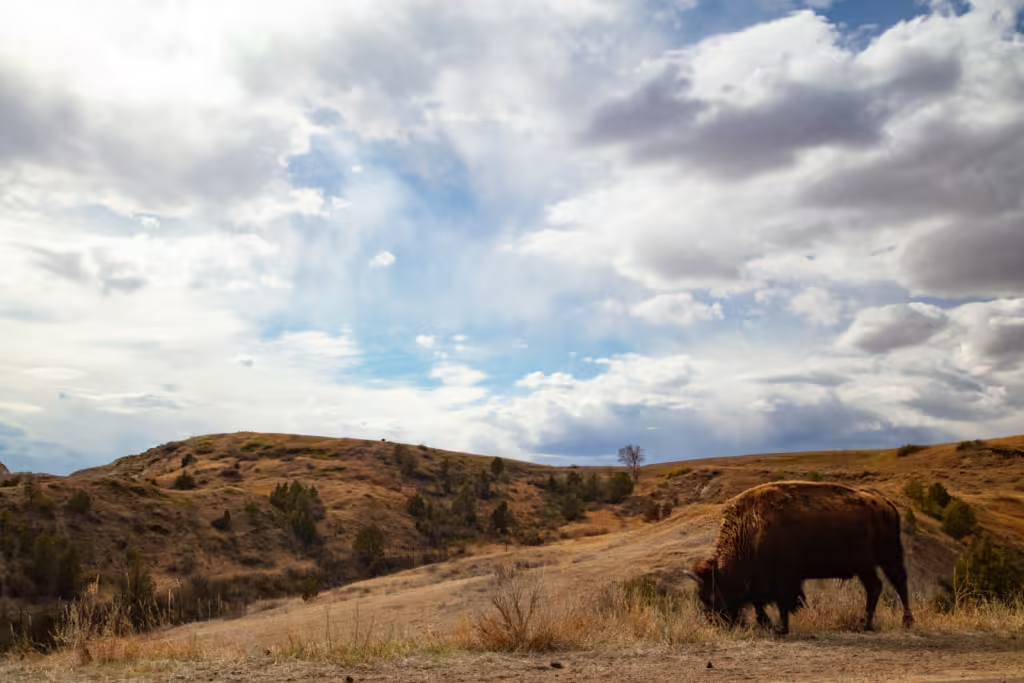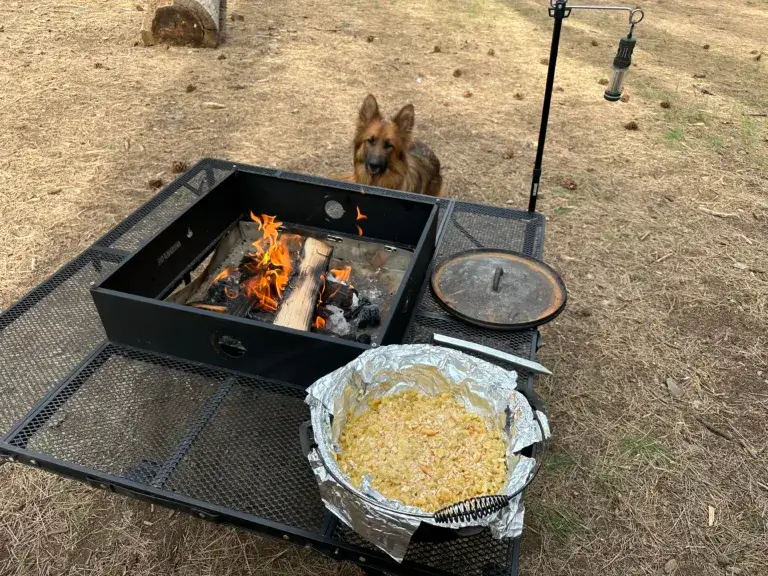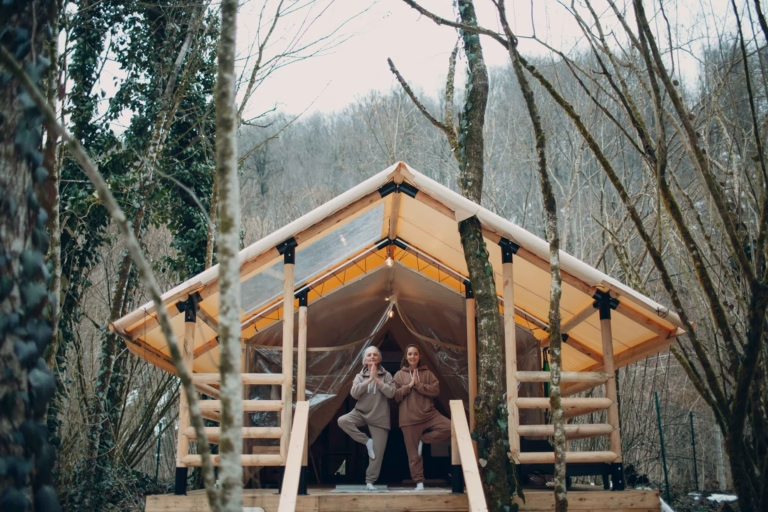Badlands Boondocking Area: Your Guide to Free Camping in This Breathtaking Wilderness
Looking for an outdoor experience that actually feels wild? The Badlands Boondocking Area, or “The Wall,” is hands-down one of the most spectacular free camping spots in South Dakota.
It’s about 6 miles south of Wall on Highway 240 and just a mile from the Pinnacle entrance to Badlands National Park. Here, you get jaw-dropping views that put you right on the edge of the Badlands—no fences, no crowds, just you and the sunrise.
Camping here is free and gives you a front-row seat to the raw beauty of the landscape.

We’ve spent evenings here, just watching the sun melt behind those colorful rock formations. Our camper usually sits right at the edge of this wild place, and it’s hard to beat that feeling.
This government-controlled land stays open all year, so it’s perfect for exploring the park or just unplugging for a while.
There’s plenty of space, even during busy times, but if you want the best views, try to arrive early. Trust me, it’s worth it.
Key Takeaways
- The Badlands Boondocking Area has free camping with direct views of the park, just 6 miles south of Wall, South Dakota.
- This public land is open year-round and sits minutes from the Pinnacle entrance to Badlands National Park.
- Bring all your supplies for off-grid camping and get there early if you want the best panoramic views.
Getting to Know Badlands Boondocking
Free camping with killer views—that’s what makes the Badlands boondocking experience such a favorite for us. It’s become one of those places we keep coming back to when we want to unplug and just soak in the scenery.
The Allure of Badlands National Park
Badlands National Park has some of the most dramatic scenery in the country. The layered rocks, steep canyons, and spires make a wild backdrop for our camping adventures.
When we first saw the “Badlands Wall,” we just stared. It’s a natural formation that gives you an unreal panoramic view of the park’s terrain.
Sunrise here feels almost magical. The morning light turns the rocks gold, and you can’t help but stop and watch.
Wildlife makes things even better. We’ve seen bison, bighorn sheep, and plenty of prairie dogs. And at night, the skies are so dark you can see way more stars than you’d expect—perfect for stargazing.
Boondocking Basics in the Badlands
Finding a spot to camp is actually pretty easy here. The main boondocking area, called “The Wall,” sits on public land just south of Wall, and it’s totally free year-round.
To get there, you’ll want to:
- Head south from Wall, SD on Highway 240
- Watch for the dirt road heading east
- When you hit the Badlands Wall, pick your camping spot with the view you want
Plug 43.8898, -102.227 into your GPS if you need directions. The best part? Most vehicles can get here without much trouble.
Just remember, there are no facilities. We always bring extra water, food, and make sure our batteries are topped off before we arrive.
Preparing for Your Adventure

Boondocking in the Badlands takes some planning if you want to stay comfortable and safe. The place is remote, so you have to think ahead for basics—but that’s part of the charm, right?
What to Pack for Boondocking
When we’re heading to the Badlands boondocking area, we always try to pack smart. Weather changes fast out here, so we stick to layers for clothing.
Cell service is spotty, so a good GPS or offline maps are non-negotiable. Our basic packing list usually includes:
- First aid kit and any meds we might need
- Headlamps and backup batteries
- Sunscreen and bug spray
- Binoculars for wildlife
- Camera gear (sunrises here are unreal)
- Extra water jugs
- Portable toilet if your RV doesn’t have one
Camping chairs are a must for those sunrise and sunset views. A good book or a stargazing guide is always nice for those quiet evenings, too.
Securing Provisions and Supplies
The closest real grocery stores are 30-45 minutes away, so we always stock up ahead of time. Rapid City is our go-to for shopping before we head out, and we focus on:
Groceries:
- Shelf-stable foods
- Produce that doesn’t spoil fast
- Easy meals
- Plenty of snacks for hikes
Ice is gold out here. We usually buy several bags in Wall, SD before we set up camp, and a high-quality cooler makes a huge difference.
For cooking, we bring propane for the grill and stove. We estimate about a pound per day for cooking, maybe more if the weather’s chilly and we need a heater.
Water is crucial—plan on 1-2 gallons per person per day, depending on the weather and what you’re up to.
RV Essentials for the Boondocker
There are no hookups at these sites, so we’ve learned to make our RV as self-sufficient as possible. Our power setup usually looks like this:
- Small generator for coffee and charging at night
- Solar panels if we can swing it
- Extra batteries
- LED lights to save power
For waste:
- Bring extra holding tank capacity if you can
- Portable waste tanks help for longer stays
- RV-friendly toilet paper and tank treatments
We always fill our propane tanks before getting to the Wall overlook. Water tanks are topped off, too, but we watch our weight on those bumpy dirt roads.
Basic RV tools and spare parts? Don’t skip those. You’re a long way from help out here!e’re far from service centers out here in the beautiful wilderness!
Selecting the Perfect Spot
Picking a boondocking spot in the Badlands comes down to views, privacy, and how easy it is to get there. We’ve spent a lot of nights under these stars, so here are our best tips for finding your own magic spot.
Views and Vistas in the Badlands
This place has some of the wildest scenery in America, so start by looking for a spot with a killer view. Once you hit the “Badlands Wall,” you can go either direction and find something special.
We like the eastern edge for sunrise—those golden colors on the rocks are unreal. Higher ground usually means better views of the striped hills and deep ravines.
The Buffalo Gap Grasslands next to the park give you awesome views of both the badlands and the endless prairie. We love spots where you can see the Black Hills in the distance at sunset.
Keep in mind: a great view often means more wind, so make sure your rig can handle it.
Finding Solitude Among the Hills
One of the best things about boondocking in the Badlands is how easy it is to find real solitude. We like to drive at least a mile down the gravel roads to get away from any crowds that gather near the entrance.
If you want more privacy, try coming during the week or early in the morning. On busy weekends, keep driving—there are plenty of quiet spots if you’re willing to explore a bit.
The Buffalo Gap area is especially good for finding private nooks between the hills. Here are a few tips for more solitude:
- Skip the obvious pull-offs
- Pick a spot behind a hill or natural barrier
- Stay away from popular trails and overlooks
- Consider spring or fall for fewer people
Accessibility and Road Conditions
Views and privacy are great, but you need to get there first! The dirt roads change a lot with the weather.
Most of the time, the roads are unpaved but fine for most vehicles if it’s dry. After rain, though, even 4WD can struggle.
We always check the weather before heading out. Some things to keep in mind:
- Road Type: Graded gravel at first, but rougher the farther you go
- Turn-Around Space: Make sure there’s room for your rig
- Cell Service: Pretty unreliable—don’t count on it
- Distance from Park: Sometimes being just outside the park is the sweet spot for access and scenery
If you’re worried about the roads, scout ahead without your trailer first. It takes a little extra time, but it’s worth it to find the perfect spot.
Activities and Attractions
The Badlands boondocking area is full of adventure. You’ll find everything from tough hikes through wild terrain to quiet moments spent spotting wildlife.
Honestly, there’s something here for just about anyone.
Hiking the Rugged Badlands
The iconic overlooks and scenic trails in Badlands National Park deliver hiking experiences you won’t soon forget. We’ve noticed early mornings have the best lighting for photos and cooler temps, especially in summer.
The Notch Trail is our go-to moderate hike. There’s a wooden ladder climb and some amazing canyon views packed into just 1.5 miles round trip.
If you want something easier, try the Door Trail or Window Trail. Both are short—under a mile—and still have those classic Badlands vistas with barely any effort.
For a real challenge, Castle Trail stretches about 10 miles round trip. We always bring extra water and plenty of sun protection since there’s basically no shade out there.
Experiencing Wildlife and Flora
This area is a dream for wildlife lovers. We’ve seen bison, bighorn sheep, prairie dogs, and all kinds of birds right from our camper.
The Sage Creek area is especially good for spotting animals. Early morning and dusk are the best times—bring binoculars if you’ve got ‘em.
Prairie dog towns are always fun to watch. These little guys dart in and out of their burrows, barking at each other when something catches their eye.
Spring brings a burst of wildflowers, while fall turns the grasses golden. The landscape just keeps changing, which is part of the magic.
Attractions Beyond the Badlands
When we get the urge to roam beyond our favorite boondocking spot, there’s plenty nearby.
Mount Rushmore is about an hour away. We like to visit for the presidential faces—if you catch the evening lighting ceremony, it’s pretty moving.
Wall Drug is a quirky, must-see stop just minutes from the area. Free ice water, homemade donuts, and weird photo ops—what’s not to like?
The Minuteman Missile National Historic Site gives you a peek into Cold War history. Silo tours need reservations, but the visitor center is worth a look even if you can’t get on a tour.
Responsible Boondocking

When we camp in places like the Badlands, we have to look after the land. Good habits out here keep these wild places open for everyone.
Leave No Trace Principles
The seven Leave No Trace principles are our go-to rules when boondocking in Buffalo Gap National Grassland. We plan ahead and bring everything we’ll need.
We always use existing campsites and park on tough ground to protect the grasslands. It’s a small thing that makes a big difference.
We pack out everything—no exceptions. There’s always a trash bag in our RV, and we never leave a trace.
Here’s our quick waste checklist:
- Pack out all trash (even the tiny stuff)
- Use restrooms if they’re there
- Dig catholes 6-8 inches deep and 200 feet from water
- Never dump any tanks on public land
Respecting the Land and Wildlife
When boondocking near the Badlands, we’re guests in the home of the animals who live here all year. We keep our distance and never feed wildlife—no matter how cute they look.
We’re careful with fires. If fires are allowed, we stick to fire rings and keep them small.
The plants in the National Grasslands are delicate. We don’t pick flowers, rocks, or artifacts—these belong to everyone.
We stay on marked roads and parking areas. It’s tempting to drive further, but the land is fragile and slow to heal.
We keep noise down and respect quiet hours so everyone can enjoy the sounds of this wild place.We also respect quiet hours and keep noise levels down, allowing others to enjoy the natural sounds of this amazing boondocking area.
Maximizing Your Enjoyment
Boondocking in the Badlands is more than just parking your RV. The real magic comes from syncing up with nature and connecting with the land—and, sometimes, with the people around you.
Catching the Sunrise and Sunset
Watching the sun rise or set over the Badlands is tough to beat. We think “The Wall” is one of the best sunrise spots around.
To really soak it in, try these:
- Point your chair east for sunrise, west for sunset
- Have your coffee or drink ready before the show
- Keep your camera handy, but don’t forget to just watch
- Arrive 20-30 minutes early to settle in
The colors shift minute by minute. We love how the rocks go from blue to orange and red as the sun moves across the sky.
Stargazing and Nighttime Serenity
The Badlands boondocking area is fantastic for stargazing. There’s hardly any light pollution out here, so the sky really puts on a show.
For the best night sky experience:
- Download a stargazing app before you arrive
- Bring a comfy, reclining chair
- Pack extra layers—it gets cold at night
- Use red-light headlamps to save your night vision
We like to set up away from our RV lights to really see the stars. On a clear night, the Milky Way stretches across the sky, and you’ll probably catch a few shooting stars too.
Connecting with Fellow Travelers
Meeting other adventurers is a highlight at this top-rated boondocking spot. The open layout makes it easy to chat while still giving everyone space.
We’ve made great friends just by:
- Strolling past campsites and saying hi
- Swapping tips about trails or animal sightings
- Hosting impromptu sunset hangouts
- Offering help if someone looks stuck
It’s good to respect people’s space and downtime. Most folks out here like a mix of friendly faces and quiet moments.
The community is usually helpful and down-to-earth—if you’re in a jam, someone will probably lend a hand.up.
Navigating Daily Life off the Grid

Living out here means letting go of the usual comforts, but honestly, that’s part of the fun. With some planning and a bit of flexibility, off-grid life feels more like an adventure than a hassle.
Power and Water Management
Resource management is the secret sauce for a great Badlands boondocking trip. We bring a good generator and solar panels if we can swing it. A generator keeps the basics running, while solar is quiet and eco-friendly—can’t beat that.
We usually run the generator in the morning or early evening to avoid bothering neighbors. Solar’s our favorite, though, since it’s silent and just works.
Water conservation becomes second nature. We bring at least 1-2 gallons per person per day, plus a little extra for dishes and washing up.
To make it last, we use biodegradable wipes and keep dishwashing to a minimum.
Ice tip: Go with block ice for your cooler or fridge—it lasts way longer than cubes. You can usually grab ice in Wall, South Dakota, about 6 miles away.
Trash Disposal and Sanitation
“Pack it in, pack it out” is non-negotiable when boondocking in the Badlands. We always bring strong trash bags and a secure bin to keep animals out.
If you’ve got an RV bathroom, use it. Otherwise, a portable toilet or proper wilderness bathroom etiquette works—dig a cat hole 6-8 inches deep and 200 feet from water.
Here’s our must-have list:
- Biodegradable soap
- Hand sanitizer
- Toilet paper in a waterproof bag
- Heavy-duty trash bags
- Disinfecting wipes
Leaving no trace is the goal. We want future visitors to find the Badlands just as wild and beautiful as we did.
Staying Connected Technologically
Even though we’re off-grid, we’ve figured out how to stay a little connected out here in the Badlands. Cell service changes a lot—higher ground usually means better bars.
We use a cell signal booster in our RV, and honestly, it’s made a huge difference for off-grid adventures. A lot of boondockers go for satellite internet too if they want more reliable access.
For entertainment, we always download movies, podcasts, and books before we get here. Solar-powered or rechargeable speakers let us play music without killing our main batteries.
If we really need full connectivity, we’ll drive into Wall or Rapid City. Those trips double as runs for ice, water, and groceries.nd groceries. The Badlands boondocking lifestyle is about finding that perfect balance between disconnecting from the grid and staying connected enough for comfort and safety.
Safety Considerations

Boondocking in the Badlands means you’ve got to stay alert to the environment and any hazards. We’ve learned that a little preparation goes a long way toward keeping things fun and safe.
Wildlife Encounters
The Badlands are home to all sorts of wildlife, and they deserve our respect and space. We always watch for rattlesnakes in the warmer months, especially when we’re hiking or setting up camp.
We keep food locked up in sealed containers so we don’t attract coyotes or little critters. If you bring pets, keep them leashed—too many close calls with curious pups poking around where they shouldn’t.
Wildlife viewing is best from a distance, and binoculars are a must. Never approach or feed wild animals, no matter how chill they seem.
We’ve found that keeping our distance helps us stay safe and lets animals do their thing without interference.
Weather Awareness and Preparedness
The weather out here can go from zero to wild fast. Summer days often hit over 100°F, so heat exhaustion is a real risk. We always bring at least a gallon of water per person per day when we’re out here.
Thunderstorms can roll in suddenly, bringing lightning, flash floods, and big winds. We keep a weather radio close and check the forecast before heading out. When storms hit, we steer clear of high spots and open ground.
Winter’s a different beast—freezing temps and occasional snow. We always pack for weather that’s 20° colder than what the forecast says, just in case.
The terrain gets slick and unstable when it’s wet or icy, so moving around can get dicey. Since there’s barely any shade, we bring pop-up canopies, wide-brimmed hats, and sunscreen to fight off the sun.
Wrapping Up Your Trip
When our Badlands trip wrapped up, we already started talking about coming back. Before we leave, we always pack up carefully and make sure there’s no trace of us left behind. This beautiful boondocking area deserves respect and care.
Leaving the Badlands Boondocking Area is pretty easy—you’re just a short drive from I-90, so heading east or west is a breeze. We do a last walk-around at camp to make sure nothing’s left behind.
If we’ve been out here for a while, sometimes we treat ourselves to a night at an RV park with full hookups. There are a few within an hour where you can dump tanks, do laundry, and finally get a real shower.
Don’t forget to restock before you roll out to your next spot. Wall, SD (yep, the one with Wall Drug) is close by and has most of what you need.
We love sharing our experience with other travelers. Boondocking in the Badlands is easily one of our favorite free camping spots in the country.
Check the weather before you leave—things can change fast out here. If you’re not ready to go, the nearby campground at Badlands National Park is a solid backup.
Safe travels, friends. Hope your Badlands trip was as unforgettable as ours.
Frequently Asked Questions
Boondocking in the Badlands is a unique way to see this wild place. Here are answers to questions we get all the time—hopefully they’ll help you plan your own off-grid adventure.
What are the best spots for boondocking in the Badlands area?
Sage Creek Rim Road is hands-down the most popular boondocking spot here. You get amazing Badlands views and it won’t cost you a thing.
We love waking up to those sunrises right outside our camper. There aren’t marked sites, so you can pick your own perfect patch along the rim.
Just know there are zero amenities, so come ready with everything you’ll need.
Are there any areas for free camping near the Badlands that you would recommend?
Buffalo Gap National Grassland is fantastic for free camping right next to the park. We especially like the areas along the southern boundary.
It’s all true off-grid camping—no hookups, but the views and wildlife make up for it. Bison and bighorn sheep wander by pretty often!
The roads can get rough, so take it slow (seriously, you’ll thank yourself later).
How does Cedar Pass Campground compare to other camping options around the Badlands?
Cedar Pass is the main developed campground inside the park, and it has more amenities than the boondocking spots. Unlike the free areas, you get water, flush toilets, and picnic tables.
It’s convenient but definitely busier and less private than boondocking. You’ll need to reserve ahead, especially in summer.
On the plus side, rangers are close by and you’re right next to the park’s main sights. That can be a big deal for families or folks new to camping.
Is it possible to camp at Sage Creek Campground without a reservation?
Yep! Sage Creek Campground is first-come, first-served, and you can’t reserve a spot. We think it’s a nice middle ground between full-on boondocking and developed camping.
It’s free and has basic pit toilets, but no water. The gravel road in can get rough after rain, so bring a vehicle that can handle it.
Try to arrive early during busy times (June through August) since sites fill up fast, especially on weekends.
Are there specific rules or tips I should know about dispersed camping in Buffalo Gap near the Badlands?
If you’re boondocking in Buffalo Gap, remember you can only stay 14 days. We always follow the “pack it in, pack it out” rule since there are no trash services out here.
Fire restrictions are common when it’s dry, so check with rangers before lighting anything. Keep your site at least 200 feet from water sources to protect the area.
The weather can go from scorching to stormy in no time, so keep an eye on the forecast and have a backup plan ready.
What should I be aware of when planning to sleep in my vehicle overnight in the Badlands?
If you’re thinking about vehicle camping in the Badlands, brace yourself for wild temperature swings. Summer days can get brutally hot, but the nights? They might surprise you with a chill, so toss in extra bedding and plenty of layers.
Definitely pack more water than you think you’ll need. There are no hookups out there, and the dry air sneaks up on you—dehydration happens fast. I’d say at least a gallon per person per day, but honestly, more never hurts.
Wildlife is part of the deal here. You could spot bison or even rattlesnakes, so keep your food locked up tight. Stay alert, especially around dawn and dusk, since that’s when animals like to wander close.








